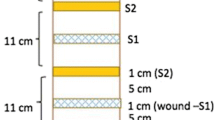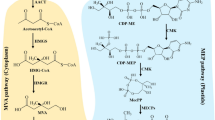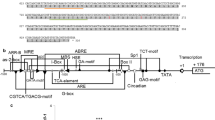Abstract
Conifers produce terpenoid-based oleoresins as constitutive and inducible defenses against herbivores and pathogens. Much information is available about the genes and enzymes of the late steps of oleoresin terpenoid biosynthesis in conifers, but almost nothing is known about the early steps which proceed via the methylerythritol phosphate (MEP) pathway. Here we report the cDNA cloning and functional identification of three Norway spruce (Picea abies) genes encoding 1-deoxy-d-xylulose 5-phosphate synthase (DXS), which catalyzes the first step of the MEP pathway, and their differential expression in the stems of young saplings. Among them are representatives of both types of plant DXS genes. A single type I DXS gene is constitutively expressed in bark tissue and not affected by wounding or fungal application. In contrast, two distinct type II DXS genes, PaDXS2A and PaDXS2B, showed increased transcript abundance after these treatments as did two other genes of the MEP pathway tested, 1-deoxy-d-xylulose 5-phosphate reductoisomerase (DXR) and 4-hydroxyl 3-methylbutenyl diphosphate reductase (HDR). We also measured gene expression in a Norway spruce cell suspension culture system that, like intact trees, accumulates monoterpenes after treatment with methyl jasmonate. These cell cultures were characterized by an up-regulation of monoterpene synthase gene transcripts and enzyme activity after elicitor treatment, as well as induced formation of octadecanoids, including jasmonic acid and 12-oxophytodienoic acid. Among the Type II DXS genes in cell cultures, PaDXS2A was induced by treatment with chitosan, methyl salicylate, and Ceratocystis polonica (a bark beetle-associated, blue-staining fungal pathogen of Norway spruce). However, PaDXS2B was induced by treatment with methyl jasmonate and chitosan, but was not affected by methyl salicylate or C. polonica. Our results suggest distinct functions of the three DXS genes in primary and defensive terpenoid metabolism in Norway spruce.








Similar content being viewed by others
References
Bishop-Hurley SL, Zabkiewicz RJ, Grace L, Gardner RC, Wagner A, Walter C (2001) Conifer genetic engineering: transgenic Pinus radiata (D. Don) and Picea abies (Karst) plants are resistant to the herbicide Buster. Plant Cell Rep 20:235–243
Blechert S, Brodschelm W, Holder S, Kammerer L, Kutchan TM, Mueller MJ, Xia ZQ, Zenk MH (1995) The octadecanoic pathway: signal molecules for the regulation of secondary pathways. Proc Natl Acad Sci USA 92:4099–4105
Bohlmann J, Steele CL, Croteau R (1997) Monoterpene synthases from Grand fir (Abies grandis)—cDNA isolation, characterization, and functional expression of myrcene synthase, (−)(4S)-limonene synthase, and (−)-(1S,5S)-pinene synthase. J Biol Chem 272:21784–21792
Buseman CM, Tamura P, Sparks AA, Baughman EJ, Maatta S, Zhao J, Roth MR, Esch SW, Shah J, Williams TD, Welti R (2006) Wounding stimulates the accumulation of glycerolipids containing oxophytodienoic acid and dinor-oxophytodienoic acid in Arabidopsis leaves. Plant Physiol 142:28–39
Byun-McKay SA, Hunter WL, Godard KA, Wang SX, Martin DM, Bohlmann J, Plant AL (2003) Insect attack and wounding induce traumatic resin duct development and gene expression of (−)-pinene synthase in Sitka spruce. Plant Physiol 133:368–378
Campos N, Rodriguez-Concepcion M, Sauret-Gueto S, Gallego F, Lois LM, Boronat A (2001) Escherichia coli engineered to synthesize isopentenyl diphosphate and dimethylallyl diphosphate from mevalonate: a novel system for the genetic analysis of the 2-C-methyl-d-erythritol 4-phosphate pathway for isoprenoid biosynthesis. Biochemical J 353:59–67
Croteau R (1987) Biosynthesis and catabolism of monoterpenoids. Chem Rev 87:929–954
Croteau R, Gurkewitz S, Johnson MA, Fisk HJ (1987) Biochemistry of oleoresinosis—Monoterpene and diterpene biosynthesis in Lodgepole pine saplings infected with Ceratocystis clavigera or treated with carbohydrate elicitors. Plant Physiol 85:1123–1128
Erbilgin N, Krokene P, Christiansen E, Zeneli G, Gershenzon J (2006) Exogenous application of methyl jasmonate elicits defenses in Norway spruce (Picea abies) and reduces host colonization by the bark beetle Ips typographus. Oecologia 148:426–436
Estevez JM, Cantero A, Reindl A, Reichler S, Leon P (2001) 1-deoxy-d-xylulose-5-phosphate synthase, a limiting enzyme for plastidic isoprenoid biosynthesis in plants. J Biol Chem 276:22901–22909
Fäldt J, Martin D, Miller B, Rawat S, Bohlmann J (2003) Traumatic resin defense in Norway spruce (Picea abies): methyl jasmonate-induced terpene synthase gene expression, and cDNA cloning and functional characterization of (+)-3-carene synthase. Plant Mol Biol 51:119–133
Franceschi VR, Krekling T, Christiansen E (2002) Application of methyl jasmonate on Picea abies (Pinaceae) stems induces defense-related responses in phloem and xylem. Am J Bot 89:578–586
Franceschi VR, Krokene P, Christiansen E, Krekling T (2005) Anatomical and chemical defenses of conifer bark against bark beetles and other pests. New Phytol 167:353–375
Glazebrook J, Chen WJ, Estes B, Chang HS, Nawrath C, Metraux JP, Zhu T, Katagiri F (2003) Topology of the network integrating salicylate and jasmonate signal transduction derived from global expression phenotyping. Plant J 34:217–228
Huber DP, Philippe RN, Godard KA, Sturrock RN, Bohlmann J (2005) Characterization of four terpene synthase cDNAs from methyl jasmonate-induced Douglas-fir, Pseudotsuga menziesii. Phytochemistry 66:1427–1439
Hudgins JW, Franceschi VR (2004) Methyl jasmonate-induced ethylene production is responsible for conifer phloem defense responses and reprogramming of stem cambial zone for traumatic resin duct formation. Plant Physiol 135:2134–2149
Hudgins JW, Christiansen E, Franceschi VR (2003) Methyl jasmonate induces changes mimicking anatomical defenses in diverse members of the Pinaceae. Tree Physiol 23:361–371
Hudgins JW, Ralph SG, Franceschi VR, Bohlmann J (2006) Ethylene in induced conifer defense: cDNA cloning, protein expression, and cellular and subcellular localization of 1-aminocyclopropane-1-carboxylate oxidase in resin duct and phenolic parenchyma cells. Planta 224:865–877
Keeling CI, Bohlmann J (2006a) Diterpene resin acids in conifers. Phytochemistry 67:2415–2423
Keeling CI, Bohlmann J (2006b) Genes, enzymes and chemicals of terpenoid diversity in the constitutive and induced defence of conifers against insects and pathogens. New Phytol 170:657–675
Ketchum RE, Gibson DM, Croteau RB, Shuler ML (1999) The kinetics of taxoid accumulation in cell suspension cultures of Taxus following elicitation with methyl jasmonate. Biotechnol Bioeng 62:97–105
Khosroushahi AY, Valizadeh M, Ghasempour A, Khosrowshahli M, Naghdibadi H, Dadpour MR, Omidi Y (2006) Improved Taxol production by combination of inducing factors in suspension cell culture of Taxus baccata. Cell Biology Intl 30:262–269
Kim SM, Kuzuyama T, Chang YJ, Song KS, Kim SU (2006) Identification of class 2 1-deoxy-d-xylulose 5-phosphate synthase and 1-deoxy-d-xylulose 5-phosphate reductoisomerase genes from Ginkgo biloba and their transcription in embryo culture with respect to ginkgolide biosynthesis. Planta Medica 72:234–240
Kozlowski G, Metraux JP (1998) Infection of Norway spruce (Picea abies (L) Karst) seedlings with Pythium irregulare Buism and Pythium ultimum Trow: histological and biochemical responses. Eur J Plant Path 104:225–234
Kozlowski G, Buchala A, Metraux JP (1999) Methyl jasmonate protects Norway spruce Picea abies (L.) Karst. seedlings against Pythium ultimum Trow. Physiol Mol Plant Path 55:53–58
Krushkal J, Pistilli M, Ferrell KM, Souret FF, Weathers PJ (2003) Computational analysis of the evolution of the structure and function of 1-deoxy-d-xylulose-5-phosphate synthase, a key regulator of the mevalonate-independent pathway in plants. Gene 313:127–138
Kunkel BN, Brooks DM (2002) Cross talk between signaling pathways in pathogen defense. Curr Opin Plant Biol 5:325–331
Lange BM, Ghassemian M (2003) Genome organization in Arabidopsis thaliana: a survey for genes involved in isoprenoid and chlorophyll metabolism. Plant Mol Biol 51:925–948
Lange BM, Wildung MR, McCaskill D, Croteau R (1998) A family of transketolases that directs isoprenoid biosynthesis via a mevalonate-independent pathway. Proc Natl Acad Sci USA 95:2100–2104
Lapointe G, Luckevich MD, Seguin A (2001) Investigation on the induction of 14–3-3 in white spruce. Plant Cell Rep 20:79–84
Lindmark-Henriksson M, Isaksson D, Sjodin K, Hogberg HE, Vanek T, Valterova I (2003) Transformation of alpha-pinene using Picea abies suspension culture. J Nat Prod 66:337–343
Lindmark-Henriksson M, Isaksson D, Vanek T, Valterova I, Hogberg HE, Sjodin K (2004) Transformation of terpenes using a Picea abies suspension culture. J Biotechnol 107:173–184
Lois LM, Campos N, Putra SR, Danielsen K, Rohmer M, Boronat A (1998) Cloning and characterization of a gene from Escherichia coli encoding a transketolase-like enzyme that catalyzes the synthesis of d-1-deoxyxylulose 5-phosphate, a common precursor for isoprenoid, thiamin, and pyridoxol biosynthesis. Proc Natl Acad Sci USA 95:2105–2110
Lois LM, Rodriguez-Concepcion M, Gallego F, Campos N, Boronat A (2000) Carotenoid biosynthesis during tomato fruit development: regulatory role of 1-deoxy-d-xylulose 5-phosphate synthase. Plant J 22:503–513
Martin D, Tholl D, Gershenzon J, Bohlmann J (2002) Methyl jasmonate induces traumatic resin ducts, terpenoid resin biosynthesis, and terpenoid accumulation in developing xylem of Norway spruce stems. Plant Physiol 129:1003–1018
Martin DM, Gershenzon J, Bohlmann J (2003) Induction of volatile terpene biosynthesis and diurnal emission by methyl jasmonate in foliage of Norway spruce. Plant Physiol 132:1586–1599
Martin DM, Faldt J, Bohlmann J (2004) Functional characterization of nine Norway spruce TPS genes and evolution of gymnosperm terpene synthases of the TPS-d subfamily. Plant Physiol 135:1908–1927
Miller RH, Berryman AA, Ryan CA (1986) Biotic elicitors of defense reactions in Lodgepole pine. Phytochemistry 25:611–612
Miller B, Madilao LL, Ralph S, Bohlmann J (2005) Insect-induced conifer defense. White pine weevil and methyl jasmonate induce traumatic resinosis, de novo formed volatile emissions, and accumulation of terpenoid synthase and putative octadecanoid pathway transcripts in Sitka spruce. Plant Physiol 137:369–382
Mori H, Cline K (2001) Post-translational protein translocation into thylakoids by the Sec and Delta pH-dependent pathways. Biochim Biophys Acta 1541:80–90
Nagy NE, Franceschi VR, Solheim H, Krekling T, Christiansen E (2000) Wound-induced traumatic resin duct development in stems of Norway spruce (Pinaceae): Anatomy and cytochemical traits. Am J Bot 87:302–313
Pfaffl MW (2001) A new mathematical model for relative quantification in real-time RT-PCR. Nucleic Acids Res 29:2002–2007
Phillips MA, Croteau RB (1999) Resin-based defenses in conifers. Trends Plant Sci 4:184–190
Phillips MA, Wildung MR, Williams DC, Hyatt DC, Croteau R (2003) cDNA isolation, functional expression, and characterization of (+)-alpha-pinene synthase and (−)-alpha-pinene synthase from loblolly pine (Pinus taeda): stereocontrol in pinene biosynthesis. Arch Biochem Biophys 411:267–276
Phillips M, Bohlmann J, Gershenzon J (2006) Molecular regulation of induced terpenoid biosynthesis in conifers. Phytochem Rev 5:179–189
Ralph SG, Yueh H, Friedmann M, Aeschliman D, Zeznik JA, Nelson CC, Butterfield YSN, Kirkpatrick R, Liu J, Jones SJM, Marra MA, Douglas CJ, Ritland K, Bohlmann J (2006) Conifer defence against insects: microarray gene expression profiling of Sitka spruce (Picea sitchensis) induced by mechanical wounding or feeding by spruce budworms (Choristoneura occidentalis) or white pine weevils (Pissodes strobi) reveals large-scale changes of the host transcriptome. Plant Cell Environ 29:1545–1570
Ralph SG, Hudgins JW, Jancsik S, Franceschi VR, Bohlmann J (2007) Aminocyclopropane carboxylic acid synthase is a regulated step in ethylene-dependent induced conifer defense. Full-length cDNA cloning of a multigene family, differential constitutive, and wound- and insect-induced expression, and cellular and subcellular localization in spruce and Douglas fir. Plant Physiol 143:410–424
Ro DK, Bohlmann J (2006) Diterpene resin acid biosynthesis in loblolly pine (Pinus taeda): Functional characterization of abietadiene/levopimaradiene synthase (PtTPS-LAS) cDNA and subcellular targeting of PtTPS-LAS and abietadienol/abietadienal oxidase (PtAO, CYP720B1). Phytochemistry 67:1572–1578
Ro DK, Arimura G, Lau SY, Piers E, Bohlmann J (2005) Loblolly pine abietadienol/abietadienal oxidase PtAO (CYP720B1) is a multifunctional, multisubstrate cytochrome P450 monooxygenase. Proc Natl Acad Sci USA 102:8060–8065
Rodriguez-Concepcion M, Boronat A (2002) Elucidation of the methylerythritol phosphate pathway for isoprenoid biosynthesis in bacteria and plastids. A metabolic milestone achieved through genomics. Plant Physiol 130:1079–1089
Rohmer M, Knani M, Simonin P, Sutter B, Sahm H (1993) Isoprenoid biosynthesis in bacteria—a novel pathway for the early steps leading to isopentenyl diphosphate. Biochemical J 295:517–524
Schmidt A, Zeneli G, Hietala AM, Fossdal CG, Krokene P, Christiansen E, Gershenzon J (2005) Induced chemical defenses in conifers: Biochemical and molecular approaches to studying their function. In: Romeo JT (ed) Recent advances in phytochemistry 39: chemical ecology and phytochemistry of forest ecosystems, Vol 39. Elsevier, Amsterdam, pp 1–28
Schulze B, Lauchli R, Sonwa MM, Schmidt A, Boland W (2006) Profiling of structurally labile oxylipins in plants by in situ derivatization with pentafluorobenzyl hydroxylamine. Anal Biochem 348:269–283
Sprenger GA, Schorken U, Wiegert T, Grolle S, deGraaf AA, Taylor SV, Begley TP, Bringer-Meyer S, Sahm H (1997) Identification of a thiamin-dependent synthase in Escherichia coli required for the formation of the 1-deoxy-d-xylulose 5-phosphate precursor to isoprenoids, thiamin, and pyridoxol. Proc Natl Acad Sci USA 94:12857–12862
Steele CL, Lewinsohn E, Croteau R (1995) Induced oleoresin biosynthesis in grand fir as a defense against bark beetles. Proc Natl Acad Sci USA 92:4164–4168
Steele CL, Crock J, Bohlmann J, Croteau R (1998a) Sesquiterpene synthases from grand fir (Abies grandis)—Comparison of constitutive and wound-induced activities, and cDNA isolation, characterization and bacterial expression of delta-selinene synthase and gamma-humulene synthase. J Biol Chem 273:2078–2089
Steele CL, Katoh S, Bohlmann J, Croteau R (1998b) Regulation of oleoresinosis in grand fir (Abies grandis). Differential transcriptional control of monoterpene, sesquiterpene, and diterpene synthase genes in response to wounding. Plant Physiol 116:1497–1504
Stintzi A, Weber H, Reymond P, Browse J, Farmer EE (2001) Plant defense in the absence of jasmonic acid: the role of cyclopentenones. Proc Natl Acad Sci USA 98:12837–12842
Taki N, Sasaki-Sekimoto Y, Obayashi T, Kikuta A, Kobayashi K, Ainai T, Yagi K, Sakurai N, Suzuki H, Masuda T, Takamiya K, Shibata D, Kobayashi Y, Ohta H (2005) 12-Oxo-phytodienoic acid triggers expression of a distinct set of genes and plays a role in wound-induced gene expression in Arabidopsis. Plant Physiol 139:1268–1283
Walter MH, Fester T, Strack D (2000) Arbuscular mycorrhizal fungi induce the non-mevalonate methylerythritol phosphate pathway of isoprenoid biosynthesis correlated with accumulation of the ‘yellow pigment’ and other apocarotenoids. Plant J 21:571–578
Walter MH, Hans J, Strack D (2002) Two distantly related genes encoding 1-deoxy-d-xylulose 5-phosphate synthases: differential regulation in shoots and apocarotenoid-accumulating mycorrhizal roots. Plant J 31:243–254
Zeneli G, Krokene P, Christiansen E, Krekling T, Gershenzon J (2006) Methyl jasmonate treatment of large Norway spruce (Picea abies) trees increases the accumulation of terpenoid resin components and protects against infection by Ceratocystis polonica, a bark beetle-associated fungus. Tree Physiol 26:977–988
Zhao J, Zheng SH, Fujita K, Sakai K (2004) Jasmonate and ethylene signalling and their interaction are integral parts of the elicitor signalling pathway leading to beta-thujaplicin biosynthesis in Cupressus lusitanica cell cultures. J Exp Bot 55:1003–1012
Acknowledgements
We thank Kerstin Manke (IPB, Halle) for skillful technical assistance, Xue Mei Niu (Hans Knöll Institute, Jena) for the preparation of C. polonica spore cultures and Ms. Sharon Jancsik (UBC Michael Smith Laboratories) for maintaining the EST/FLcDNA-collections of the TREENOMIX:Conifer Forest Health Project. We also thank Paal Krokene of the Norwegian Forest Research Institute (Ås, Norway), for providing the C. polonica strain. The research reported in this paper was supported with funds from the Max Planck Society (to JG), Genome British Columbia and Genome Canada in support of the TREENOMIX:Conifer Forest Health Project (grant to JB), and the Natural Sciences and Engineering Council of Canada (NSERC, grant to JB). JB is an NSERC E.W.R. Steacie Memorial fellow.
Author information
Authors and Affiliations
Corresponding author
Electronic supplementary material
Below is the link to the electronic supplementary material.
Rights and permissions
About this article
Cite this article
Phillips, M.A., Walter, M.H., Ralph, S.G. et al. Functional identification and differential expression of 1-deoxy-d-xylulose 5-phosphate synthase in induced terpenoid resin formation of Norway spruce (Picea abies). Plant Mol Biol 65, 243–257 (2007). https://doi.org/10.1007/s11103-007-9212-5
Received:
Accepted:
Published:
Issue Date:
DOI: https://doi.org/10.1007/s11103-007-9212-5




